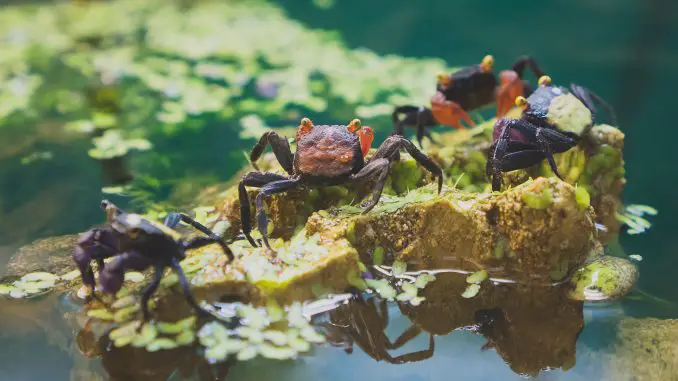
Fish aren’t for everyone; some people need something a bit more exotic. Crabs make an excellent alternative because they behave very differently and have their own unique look.
The tank will look very different from a standard aquarium, these semi-terrestrial creatures wander around on land and in water.
If you’ve decided that you want some crabs, Vampire Crabs could be the ones for you. They are small yet very beautiful, which is why they have become so popular.
See also: Thai Micro Crab
They are a great entry point for people that haven’t kept crabs before because they’re so easy to care for. All they need is a clean tank and a healthy diet.
We’ll run you through all the information you need when caring for these attractive crustaceans. This includes how to set up their tank, how to feed them, potential tank mates, and much more.
TABLE OF CONTENTS
Vampire Crab Facts & Overview

| Category | Rating |
| Care Level: | Easy |
| Temperament: | Semi-aggressive |
| Color Form: | Purple with yellow eyes |
| Lifespan: | Up to 2 years |
| Size: | Up to 2 inches |
| Diet: | Omnivore |
| Family: | Sesarmidae |
| Minimum Tank Size: | 10 gallons |
| Tank Set-Up: | Freshwater with plants and caves |
| Compatibility: | Peaceful community |
People looking to start a new tank of crustaceans have come to the right place. Vampire Crabs are an excellent choice, they have become very popular.
They are commonly sold in pet stores around the world, but outside of the aquarium trade, they are known as Geosesarma sp., since they make up the genus.
The term “vampire” isn’t used because of their behavior or feeding habits, it’s because of their purple colors and bright yellow eyes.
The Geosesarma genus is part of the Sesarmidae family. These crabs live throughout Southeast Asia and the Pacific, stretching from India all the way to Hawaii.
Vampire Crabs have a strange history. Though they’ve been kept as pets for a long time, nobody knew where they came from. It wasn’t until 2006 that they were first described.
Not all pet stores sell crabs, and if they do, they might not have the type you want, so you might need to search around for a stock near to you. They cost in the range of $10-$20; larger individuals tend to be more expensive.
These crustaceans are fairly simple to care for, but you should learn their specific requirements before purchasing any. If you keep them healthy, they should live for 2 years, which is the same as their lifespan in the wild.
Even though they don’t live very long, they are definitely worth getting. They are attractive creatures that make a nice change from keeping fish.
Typical Behavior
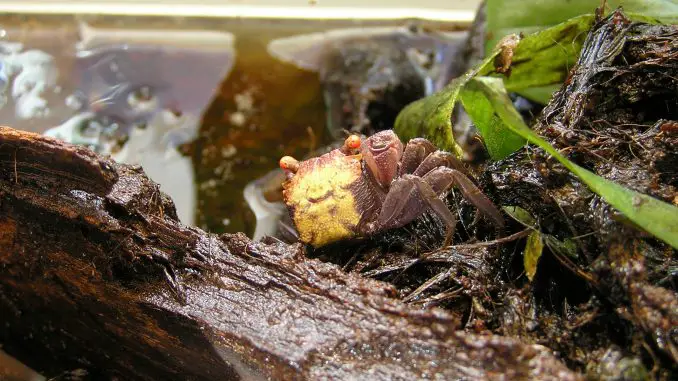
Crabs are semi-terrestrial which means they spend some of their time in the water and the rest on land. Usually, they will find a spot in the tank and sit there for hours.
Vampire Crabs are mostly nocturnal so they’re much more active at night.
A key behavior to be aware of is molting. Crabs have a hard exoskeleton for protection, but it doesn’t grow with the rest of them.
Once they get too big, they must discard the old exoskeleton so they can develop a larger one.
Molting occurs monthly, but it can be more frequent when they’re young because they are growing faster.
Your crabs will be particularly vulnerable once they’ve discarded their shell, they will hide away until the new one has grown.
Keep an eye out for when molting is taking place. Remove the old exoskeleton and leave the crab alone until it emerges with the new shell, otherwise, you might harm it.
Aggression can be a problem for Vampire Crabs. They are fine with their own species, but other species of crab or small fish are at risk of being attacked or eaten.
They use their claws to do this, but the pincers are very small, so you can handle them without fear of being pinched.
Appearance
Their appearance is probably the reason why you’re considering getting some Vampire Crabs. They are undeniably stunning animals that add beauty to whichever room they are in.
Most specimens sold in the aquarium trade are a deep purple, especially on their ten legs (which includes the pincers).
The main body (or carapace) is darker, sometimes even black, with white spots, which can look like the night sky.
The only other bits of color are their bright yellow eyes, which really stand out against the darker body. They are raised slightly above the body on stalks.
These crabs only reach a size of 2 inches, including their legs. The carapace itself is only an inch wide.
Though small, Vampire Crabs still have the key characteristics of a crab and are very recognizable. Pincers are probably the main feature of a crab, a Vampire’s pair are quite small, so they won’t be able to hurt you very easily.
There are a few ways to tell males and females apart. Just by looking you might notice that males are slightly larger and have lighter colored claws.
The most obvious difference is their abdominal flap. If you look at the underneath of the crab, males have a pointed flap whereas a female is wider and rounded.
A female might also be carrying around some fertilized eggs, which is another obvious giveaway when sexing them.
Habitat and Tank Conditions
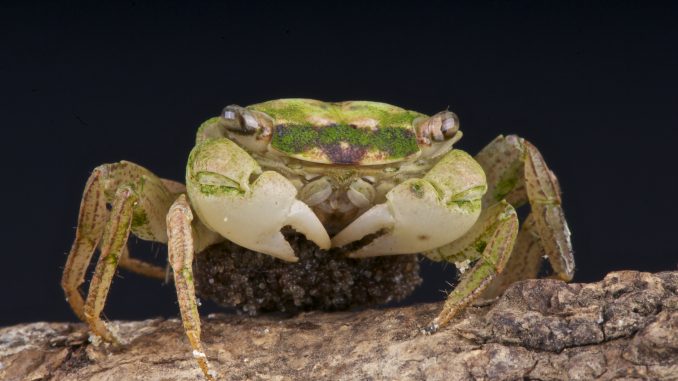
These crustaceans are primarily found throughout the Indian Ocean, in places such as India, Java, and Krakatau.
They can be found all around Southeast Asia though, and have even bee spotted in the Pacific, in places like Hawaii.
Vampire Crabs live on the edges of rivers and lakes. This gives them access to land and water to satisfy their semi-terrestrial lifestyle.
These habitats are usually dense with plants, both on land and in the water. Many people add these crabs to paludariums because of their need for plants in their environment.
They spend their time hiding among the plants or using caves from rocks and debris as shelter. Most of the day is spent sitting still in these areas.
The water itself is warm and slightly alkaline, with little water movement.
If you want your crabs to live out their 2-year lifespan then you must recreate these natural conditions as best as you can at home.
Tank Conditions
The setup is based around the fact that some dry and wet areas are needed. It is recommended to have a land to water ratio of 80:20.
There are many ways to create the land portion. You could use sand/substrate, create floating perches, or create a large platform with rocks or decorations.
There isn’t much water that you need to maintain, but it must still be kept very clean and healthy.
The temperature should be in the range of 70°F to 82°F and pH should be 7.5-8.0. Perform water changes every month to prevent a buildup of ammonia and nitrates. A filter is necessary to help keep the water clean.
Vampire Crabs are sensitive to poor conditions so react quickly if there are any changes in their environment. Water testing kits are useful for making sure the conditions are consistent.
Live plants are essential for recreating their habitat in the wild. They are needed in all areas of the tank, but you’re free to choose a range of different species.
Though these crabs will eat plant matter, they won’t eat the live plants, just dead pieces that fall away.
The shelter is important too, particularly in the water. You can use rocks and driftwood to form caves for your crabs to hide in.
A humidifier is a good idea for your setup. In the wild, Vampire Crabs would leave the water, but they’d still be in a humid environment. A humidifier will help you to maintain a humidity of 75% on the land.
What Size Aquarium Do They Need?
Since these crabs are so small, they can be kept in smaller tanks. The minimum size is 10 gallons to ensure they have plenty of space. This will let you keep a small group too.
How Many Can Be Kept Per Gallon?
A group of about six can be kept in a 10-gallon tank. If you want more, you will have to scale up the size of the tank accordingly.
Tank Mates
If you want to mix Vampire Crabs with some other species, creating a peaceful community should be your main aim. Avoid any tank mates with an aggressive or boisterous reputation.
If you want to add some fish to the tank, make sure they are of a similar size to the crabs so that neither eats the other.
Small shoaling species work well because they can get away if they need to. This includes Neon Tetras, Zebra Danios, Cherry Barbs, and Guppies.
It is best to avoid mixing Vampire Crabs with other crab species because fighting could be common. Since these crabs are quite small, they will likely be the victims.
This doesn’t mean that you must avoid all invertebrates though. Large snails and most shrimp should pair up well. There is always a slight possibility of injury, but this is rare.
Keeping Vampire Crabs Together
Keeping Vampire Crabs in groups is absolutely fine and probably the best idea. Fighting is rare, they enjoy being around their own kind.
Aggression only tends to occur during mating season, while males are trying to compete for females. Buying your crabs in a ratio of two females per male will help to keep aggression low.
If you have multiple males in the tank, then the more space you have the better. Make sure that there are lots of hiding spaces so they can stay away from each other if needed.
Diet
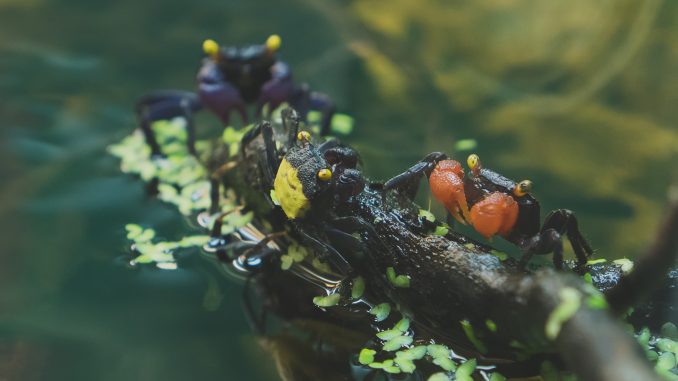
A healthy diet is important for lots of reasons. It helps a crab to grow, fend off disease and form a strong exoskeleton after molting.
Vampire Crabs are omnivores, so they will eat both meaty foods and plant matter. In the wild, they would be scavengers and eat whatever happens to come their way, like insects and pieces of dead plants.
The scavenging behavior makes feeding time at home very easy because there is such a wide range of foods to choose from. However, some foods are better than others.
The healthiest options are frozen and live foods because they retain the nutrients that are often lost during the manufacturing of dried foods.
You could pick brine shrimp, bloodworms, crickets, or even earthworms.
Vampire Crabs will accept flakes, pellets, and algae wafers, but make sure these dried foods are supplemented by the frozen/live foods to supply a range of nutrients.
Calcium is of particular importance to crabs because it helps to produce a strong shell. Adding some green vegetables (spinach, broccoli, lettuce, etc.) to the tank will help with this. You could use your leftover vegetables to make some homemade foods too.
Though these crabs will happily eat these green vegetables, you don’t need to worry about them eating the live plants in your tank, they’ll only eat detritus (dead plant matter).
Feeding only needs to happen once per day. If they get hungry then they’ll start to search for organic matter that will already be in the tank anyway.
Care
Caring for these crustaceans is simple. They are not very demanding, they just need a healthy diet and a clean environment, the same as any other pet.
We’ve already explained how to set up the perfect tank, which they need in order to thrive.
Tank maintenance isn’t much of a problem because Vampire Crabs don’t produce much mess. Check the tank regularly and clear up any debris from the plants or any shells from molting.
If you don’t have much water due to using a small tank, it can be difficult to maintain healthy conditions since it’s easier for pollutants to build up.
The solution is usually to perform more frequent water changes. Use a water testing kit each week to ensure that conditions are ideal, you can then fix issues quickly.
A gravel vacuum cleaner is an easy way to keep the substrate clean.
If you ever need to add chemical into the tank, check the bottle for any signs of copper. This is toxic to most invertebrates and could be fatal to your crabs.
If you notice that your crabs have damaged shells, then you may not be feeding them a nutritious diet. They need plenty of calcium. Switch up the diet and watch for improvements over time.
Vampire Crabs are hardy and don’t tend to get ill very often, but it can happen. They can get bacterial infections, fungal problems, and parasites just like fish.
They aren’t susceptible to common fish diseases though, like ich. They can carry these pathogens though, so quarantine your crabs when you bring them back from the store.
Many pathogens are introduced when adding new tank mates from a store. Pathogens thrive in poor water conditions, so keeping a clean tank is an easy way to keep them at bay.
Breeding
If you’re looking to breed crabs, then this variety may not be the best option. This is more due to the lack of information available on Vampire Crab breeding, rather than them refusing to mate.
Different species mate in different ways. The best thing you can do is feed them well and keep their tank clean. Hopefully, they will start mating in their own time.
It takes about six months for a crab to become sexually mature and they’ll reproduce for the rest of their life.
When ready, the male will climb atop the female to fertilize her eggs. She will then carry 20-80 fertilized eggs until they hatch after a month or so.
The young crabs emerge fully formed, but very small. It is safest to separate them from the parents because sometimes they can become cannibalistic.
Provide small crabs with lots of hiding spaces so they can keep away from each other if necessary.
Since baby Vampire Crabs are fully formed, they can be independent and look after themselves.
If you manage to successfully breed them, it could be useful to write down how you did it since little information is available on how to boost the chances of them mating.
Are Vampire Crabs Suitable for your Aquarium?
Anyone can look after Vampire Crabs; they are some of the easiest crabs to care for, so they won’t use up much of your time.
Of course, there are certain things that you need to know, but after reading this article you should feel ready for the commitment.
The main things to consider are their perfect setups and the ideal diet. These won’t be much of a problem, but they can be confusing if you haven’t kept crabs before.
Picking the right tank mates is important too, but there are plenty of options out there for you to start your own peaceful community.
Vampire Crabs are very attractive, you might have decided to get some the moment you laid eyes on them. Whatever the case, these are some wonderful animals that will keep you transfixed.
Do you like Vampire Crabs? Let us know why in the comments below…

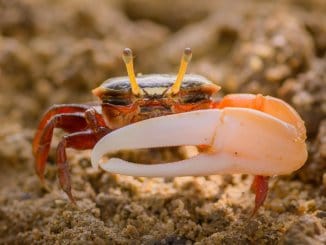
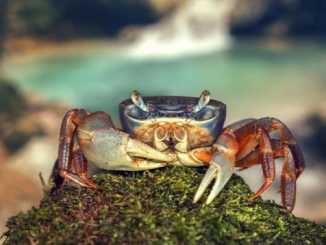
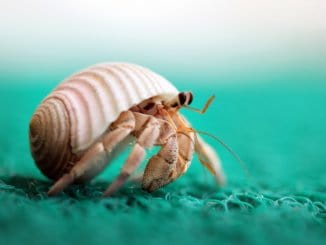
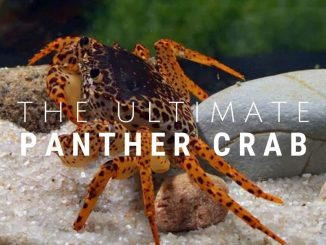
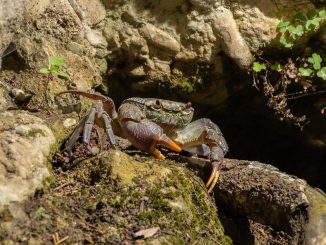

I fell in love with vampire crabs. Not a ton of information. So do the purple clawed ones always have a yellow back? In your pick there is one with orange claws? Name? I have 3 different types. The purple clawed with no yellow on their back. Do they get yellow with age? I have orange/redish clawed ones with orange/redish on their backs(assuming red devil)and I have plain orange clawed ones. I have a video of one eating one of my little lily pads. 2x I have caught them eating the live Lilly pads but none of the other plants in the tank just floating ones
Hi Robert,
Thank you for this detailed care guide for Vampire Crabs!
I started keeping three crabs (two females, one male) several months ago in a small but heavily planted paludarium (80% land / 20% water).
To my surprise I recently noticed two tiny crabs hanging out in the water portion of the paludarium (basically miniature versions of the adults). I was hoping to find more but caught one of the adult munching on a baby crab… I guess several others met the same fate. I since isolated the survivor in a small tank to avoid any further incident.
In term of parameters, The paludarium temperature is 77F, humidity is 90%+. The substrate in the water portion is very small gravel mixed with a bit of crushed coral, substrate on the land side is ZooMed Reptisoil. Fern, Rabbit foot fern, java moss and bromeliad cover most of the land portion, chola wood in both the land and water portion of the paludarium to offer hiding places. A small filter keeps the water clean.
In term of food: mainly Hikari crab cuisine supplemented by live crickets and mealworms.
Not sure if this information will be useful to people looking into breeding Vampire Crabs, but happy to share more details if need be!
Good day, Robert!
I have successfully produced 13 new vampire crabs with a male and female pair. In a 10 gallon tank, I prepared an environment consisting of many plants and niches in pieces of driftwood in which the female could hide. Temperature was around 73 degrees, humidity close to 100%. 2 gallons of water were in the tank. I did not use a filter, only a bubbler. Several months after I bought them, I began to notice small crabs sprinting about the place, obviously weary of their parents. The next day I had ready another ten gallon with the same conditions into which I transferred the parents. I did not bother to change the water for at least a month, since they made little mess and were probably too small not to be sucked up by my siphon. As of April 12th, 13 baby crabs have survived to their second molt. I fed them a diet of many vegetables, dried shrimp, and frozen bloodworms. Most of the time the vegetables were carrots, celery, and cucumber.
I hope this description helps someone. I was able to sell 7 back to the store, although they are still small, I simply didn’t have the space for 15 vampire crabs! The rest I am raising with their parents in a new 20 gallon tank, this time with a proper filter.
Thanks.
How do we clean the vampire crab tank and how often? Thanks so much!!!
Hello,
I appreciate all the ‘overview’ info, but there is such a lack of specifics out there! For example, coming from a humidity stand point, what is better? A standard aquarium & screened top or a terrarium with a screened top? What kind of filter system? A detailed list of items and brand names would be very helpful!
I don’t live in a place with an advanced pet store…just a very lame Petco & PetSmart! They are totally clueless.
I want to set up my habitat before getting the crabs.
The terrariums don’t seem to have the horizontal space that an aquarium has. I was thinking a 20 gallon long…with a screened top and maybe putting plexiglass over 1/2 of the top as I know air circulation is also important.
Would a small tetra fauna a filter work (like the kind used for frogs & newts? If anyone has had success can they please share specifics! Kindest regards,
Hi, I am setting up a vampire crab paludarium. It will be 80/20 land to water, and I will have a heater and filter in there. I was wondering what plants would be best for the land and water sections? The drainage layer will be hydroballs with a layer of reptilsoil on top. What would be some good floating plants? And could i use java moss for the land section? Would it be okay if I rotated their diet from green vegetables with frozen/live foods and maybe some crab cuisine or other prepared foods? The tank will be either 10 or 12 gallons long, and I am wondering how many I could put in there? Thanks
Hi I just recently saved 2 vampire crabs and I added them to my community tank with 3 med koi and a large gold fish. I added some turtle docks on the top with a few ways to crawl up to the top. I was wondering Is this good enough for them?
I’ve heard that bigger fish can eat vampire crabs. I would be particularly careful since gold fish and koi can get so big! Best of luck.